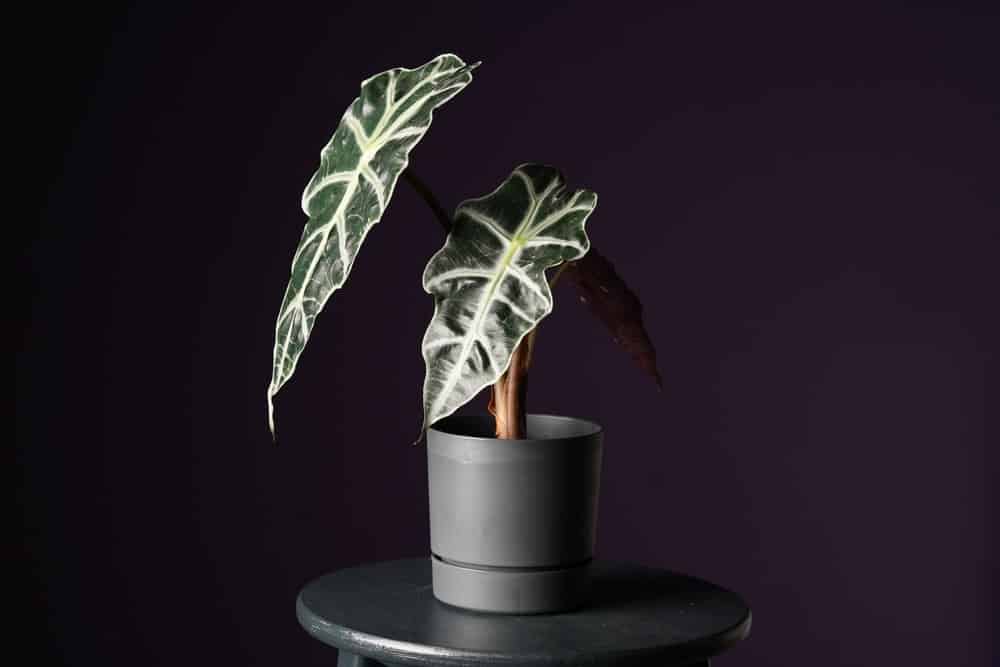The more common name that people know this plant by is Elephant Ears.
They do give the grower some challenges that are not small but the beautiful foliage is just one of the reasons to have this plant in your home. One day, you notice the leaves turning yellow but what is causing it? Read on to find out.
The Alocasia Polly Plant
This is a hybrid plant with an unknown co-parent to the Alocasia. It is high maintenance and can be temperamental at times. The Alocasia Polly is a native to the rainforests in Asia so it needs high temperatures and a moist environment. The plant has dark green glossy leaves that are shaped like scalloped arrows. It gets its striking appearance from the bold silvery-green veins you find across the leaves. It needs full to moderate sun with organic soil that is full of healthy nutrients. Water it enough to keep the soil moist.
Why Alocasia Polly Plants Gets Yellow Leaves
1. Lighting
This plant needs to have filtered light if you are putting it in a bright room. Do not let it have direct sunlight as this can cause yellowing and browning of the leaves because it is too harsh. Direct sunlight will synch the leaves.
2. Watering and soil moisture
Regulating soil moisture is important for all houseplants, especially the high moisture plants. Your Alocasia Polly plant needs water and takes in a lot of water every few days. If you give it too much water it can lead to root rot because the soil if it is poorly drained so the plant sits in the water. You want the soil moist but not drenched. Water it once a week but do not drench it. When it goes into dormancy, reduce the water but do not let it dry out completely.
3. Temperature and humidity
Since the Asian rainforest is its natural home, the temperature and humidity are very important. The Alocasia Polly needs consistent temperature and moisture to prevent drying and yellowing of the leaves. If you are living in a dry climate you may need to compensate to keep it healthy. You should keep your home at 60 degrees F. during the day and at 70 degrees F. at night
4. Unfiltered water
You should try not to give any plants tap water as there are minerals in tap water that could harm the plant’s soil. The water often has mineral buildup causing hard water. Minerals like calcium, sodium, copper, magnesium can buildup in the soil and prevent the soil from absorbing moisture and water correctly. This lack of moisture can cause yellow leaves.
5. Pests
Mealy bugs, aphids, ad spider mites are the pests most often affect your plant. They can do a lot of damage to your Alocasia plant by damaging the plant cells, kill it off completely, deform stems or the entire plant, etc. Spider mites love to drain your plant of moisture by sucking out the sap. If you see any of these pests you need to eradicate them before they move on to other parts of your plant.

Treatments
Lighting
One way to fix this is to put the plant in a room where light fills it entirely but it has to be indirect sunlight. You can also put up sheer curtains. By doing this, it will allow less intense light to shine in.
Watering and soil moisture
One way you can help make sure that you are watering your plant correctly is to use a watering meter. It will allow you to check the moisture of your soil to make sure that it is in perfect rage. You also have to make sure that the leaves are filling up with water and that the soil is well-drained. The plant also needs to be potted in the right soil, which is soil that is well-draining and loose. The soil needs to act like a filter for the water so the roots get the right amount. Maintain a watering schedule because this will prevent periods of drought or drenching.
Temperature and humidity
One way to fix the humidity problem is to buy a humidifier, which puts moisture in the air by releasing water vapor that feels like misting. This does replicate its natural habitat. You can also change where you currently have it to a place where the lighting is better and has a better level of humidity. Two places in your home have the right humidity and those are the bathroom and kitchen. You can also create humidity with wet stones in a pebble tray. Put some pebbles on a tray and cover them halfway with water. As the water evaporates, it will put humidity in the air.
Unfiltered water
The best thing to do is buy a water filter that does on your faucets to create water without all those minerals. When you use tap water for your plant filtering will prevent the buildup of minerals and make it safe to use on your plants. You can also buy filtered water at the store.
Pests
The best solution is to stop the problem from the root. First, you need to know which pests are attacking your plant. To help prevent any pests from being on your plant is to keep it dust-free because some pests are the strongest when in dusty conditions. You can also wipe the leaves off, or use an insect oil to kill the pests off.
Conclusion
As you can see, the Alocasia plant can have many challenges; probably more than the average houseplant. You should not have problems as long as you give your plant the right environment in which to live. If you do see the leaves turning yellow, assess the problem quickly, and fix it before you lose your plant. Generally, the most common problem for yellow leaves on your Alocasia Polly plant is due to improper soil moisture. This means your plant has been over-watered.
Some yellowing is natural because they are the older leaves, especially at the bottom of the plant. The plant is shedding the older leaves to make room for new growth.
Also read:
Victoria is the owner and main author of hobby plants. She loves spending her free time in her garden planting and taking care of her plants. Victoria hopes you enjoy the content here!

![Why Are My Orchid Leaves Turning Yellow? [Find Out Here] Why Are My Orchid Leaves Turning Yellow? [Find Out Here]](https://www.hobbyplants.com/wp-content/uploads/2022/07/orchid-leaves-turning-yellow-300x158.jpg)
![Why Is My Bamboo Plant Turning Yellow? [Find Out Here] Why Is My Bamboo Plant Turning Yellow? [Find Out Here]](https://www.hobbyplants.com/wp-content/uploads/2022/07/why-is-my-bamboo-turning-yellow-300x158.jpg)
![Why Is My Fiddle Leaf Fig Dropping Leaves? [ANSWERED] Why Is My Fiddle Leaf Fig Dropping Leaves? [ANSWERED]](https://www.hobbyplants.com/wp-content/uploads/2022/06/why-is-my-fiddle-leaf-fig-dropping-leaves-300x158.jpg)
![Why Are My Bird of Paradise Leaves Curling? [FIND OUT HERE] Why Are My Bird of Paradise Leaves Curling? [FIND OUT HERE]](https://www.hobbyplants.com/wp-content/uploads/2022/07/bird-of-paradise-leaves-curling-300x158.jpg)
![Why Are My Peace Lily Leaves Turning Brown? [EXPLAINED] Why Are My Peace Lily Leaves Turning Brown? [EXPLAINED]](https://www.hobbyplants.com/wp-content/uploads/2022/07/peace-lily-leaves-turning-brown-1-300x158.jpg)

![Mother Of Thousands Plant [Complete Plant Care Guide] Mother Of Thousands Plant [Complete Plant Care Guide]](https://www.hobbyplants.com/wp-content/uploads/2022/07/mother-of-thousands-plant-300x158.jpg)
![Prayer Plant At Night: What Makes Them Unique? [EXPLAINED] Prayer Plant At Night: What Makes Them Unique? [EXPLAINED]](https://www.hobbyplants.com/wp-content/uploads/2022/07/prayer-plant-at-night-300x158.jpg)
![Bleeding Heart Plant Varieties [COMPLETE BEGINNER'S GUIDE] Bleeding Heart Plant Varieties [COMPLETE BEGINNER'S GUIDE]](https://www.hobbyplants.com/wp-content/uploads/2022/07/bleeding-heart-plant-300x158.jpg)
![Polka Dot Plant Care? [Everything You Need To Know] Polka Dot Plant Care? [Everything You Need To Know]](https://www.hobbyplants.com/wp-content/uploads/2022/08/polka-dot-plant-care-300x158.jpg)
![Majesty Palm Plant Care: [Complete Beginner's Guide] Majesty Palm Plant Care: [Complete Beginner's Guide]](https://www.hobbyplants.com/wp-content/uploads/2022/08/majesty-palm-care-300x158.jpg)